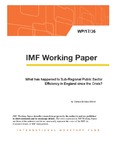Please use this identifier to cite or link to this item:
http://thuvienso.quochoi.vn/handle/11742/39077Full metadata record
| DC Field | Value | Language |
|---|---|---|
| dc.creator | Samya Beidas-Strom | - |
| dc.date.issued | February 2017 | - |
| dc.identifier.uri | http://hdl.handle.net/11742/39077 | - |
| dc.description.abstract | This paper estimates public sector service efficiency in England at the sub-regional level, studying changes post crisis during the large fiscal consolidation effort. It finds that despite the overall spending cut (and some caveats owing to data availability), efficiency broadly improved across sectors, particularly in education. However, quality adjustments and other factors could have contributed (e.g., sector and technology-induced reforms). It also finds that sub-regions with the weakest initial levels of efficiency converged the most post crisis. These sub-regional changes in public sector efficiency are associated with changes in labor productivity. Finally, the paper finds that regional disparities in the productivity of public services have narrowed, especially in the education and health sectors, with education attainment, population density, private spending on high school education and class size being to be the most important factors explaining sub-regional variation since 2003. | - |
| dc.language | en | vi |
| dc.publisher | 2017 International Monetary Fund | vi |
| dc.rights | 2017 International Monetary Fund | vi |
| dc.subject | public sector efficiency | vi |
| dc.subject | producivity | vi |
| dc.subject | sub-regional fiscal federalism | vi |
| dc.title | What has happened to Sub-Regional Public Sector Efficiency in England since the Crisis? | vi |
| dc.type | Báo cáo | vi |
| Appears in Collections: | Phân quyền - Hành chính | |
Files in This Item:
Items in DSpace are protected by copyright, with all rights reserved, unless otherwise indicated.

THƯ VIỆN QUỐC HỘI - VĂN PHÒNG QUỐC HỘI
Địa chỉ: Nhà Quốc Hội, Đường Độc Lập, Ba Đình, Hà Nội
Điện thoại: 080.41947
Email: thuvienquochoi@quochoi.vn




